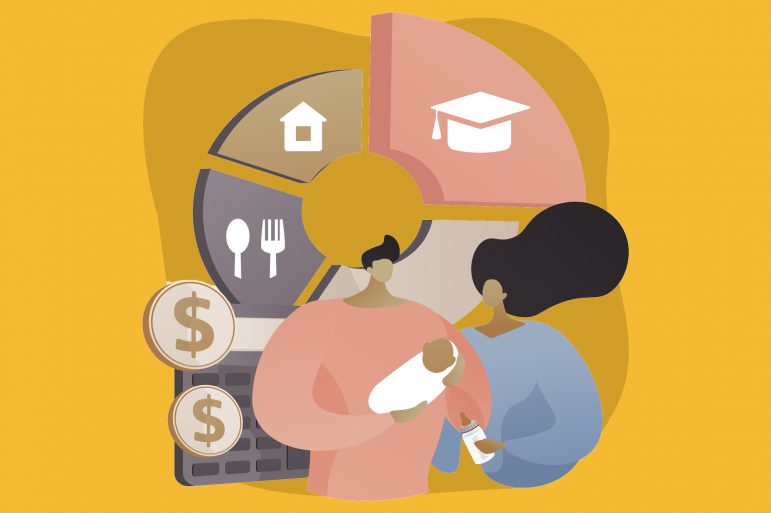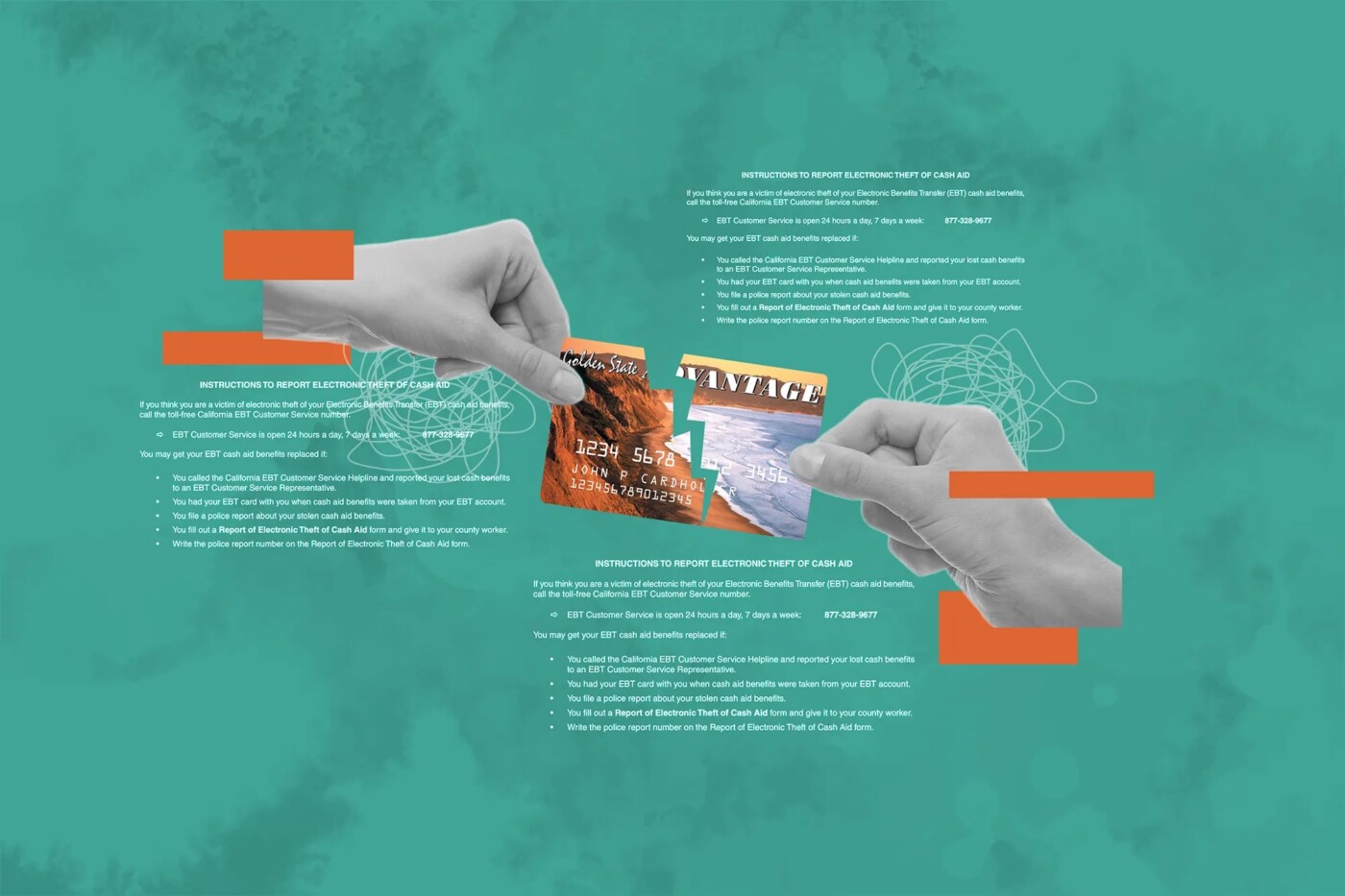The first time it happened to Courtney Abrams, hardly anyone believed her.
Someone had drained the more than $700 in cash aid and nearly $200 in food stamps from the electronic benefits transfer (EBT) card the 33-year-old single mother received from the state, just minutes after those monthly payments appeared in her account.
Abrams never got to spend a dime of it, though she hadn’t lost her card.
Abrams, a West Los Angeles College student, called the card company’s customer service line that day to dispute the mystery transactions. She got a replacement card from the county and filed a police report. It took a couple of weeks for money to be loaded onto her new card. She also changed the PIN.
That was last March. In September it happened again. This time it took a month to get her money back, she said.

In November it happened again. Now she changes her PIN every month, the night before she gets her benefits, hoping to outsmart the thieves.
“I was, like, maxing out credit cards, doing promise-to-pay, talking to my landlord, letting him know my money got stolen,” she said. “It was a lot of exposure … having to plead your case with these people in a situation that sounds kind of far-fetched.”
It’s not so far-fetched now. State and county officials say that a rash of thefts is wiping out the cash and food benefits from thousands of low-income families’ electronic benefits cards in California and nationwide.
The thefts, which cost the state tens of millions of dollars to replace each year, have sent recipients scrambling to pay bills and household expenses, and flooding social service departments with reimbursement requests. The state proposes to upgrade the cards’ security features at a cost of $50 million in next year’s budget.
California uses EBT cards to deliver financial assistance for several programs, including CalFresh, which gives food aid to 2.8 million families a year and CalWORKs, which gives cash to more than 300,000 families a year. Smaller programs include assistance grants to refugees and immigrant crime victims.
Low-income Californians reported $29.7 million in cash welfare stolen and $4.7 million in food aid stolen in the 14 months from July 2021 through last September, the latest month for which statewide data was available, according to the Department of Social Services.
In CalWORKs, the theft amounted to less than $100,000 a month in mid-2021 and had risen to more than $4 million a month by last fall. The department is estimating an average of $6 million a month will be stolen this fiscal year, rising to $8 million a month in the year that begins in July, according to the California Department of Social Services budget documents.
What has been stolen in California so far amounts to a sliver of the total benefits California issued to all recipients — less than 1% of the cash benefits and less than a tenth of 1% of food aid.
Still, the amount of EBT theft has nearly doubled since 2019, budget documents state.
It’s not clear what has prompted a nationwide spike in benefits theft last year. The consequences are particularly acute in California, which provides more generous cash grants than many other states. Advocates say pandemic-era boosts in food aid also meant bigger losses than usual from recipients’ accounts.
Often the theft occurs minutes after the benefits are transferred to their cards.
It takes much longer to be made whole. Several recipients told CalMatters it took weeks, or even more than a month, to get benefits reimbursed amid the rising theft.
The state social services department in 2013 instructed counties to replenish money to victims within 10 days of a theft report, but exceptions meant to catch fraud can slow that process.
For example, if an aid recipient reports more than one theft within six months, social workers must flag their next claim for investigation.
Many recipients say they have been victims of theft more than once in recent months. Giovanna Roman, a Ventura County mother and community college student, said it happened to her three months in a row last year. She now receives her benefits through direct deposit, she said.
One reason safety-net benefits are vulnerable to electronic theft, advocates say, is the cards have long lacked a security feature banks began putting on their credit and debit cards in late 2015 – security chips.
A chipped card doesn’t come in contact with hidden, illegal “skimming” devices, which are designed to copy information from the card’s strip.
To make purchases or withdraw money, EBT card users must swipe the cards’ magnetic strips.
A state public service video demonstrates how thieves can install skimming devices onto card readers to steal card numbers from the cards’ magnetic strips, and the thieves use hidden cameras to capture the cardholders entering their PINs.
The thieves can then create counterfeit cards to access the funds.
Until last June, the state’s EBT cards didn’t even include the three-digit “CVV” security codes typically on the back of credit and debit cards that banks use for an additional layer of fraud prevention.
The state added those codes, but the three months of data afterward show that benefits theft continued to rise, according to state figures.
The state social services department is proposing to spend $76.5 million over the next three years to upgrade EBT cards with “enhanced security features,” according to Gov. Gavin Newsom’s budget proposal. Department spokesman Jason Montiel did not answer a question about whether that means chip cards specifically.
Advocates and — in a recent motion — the Los Angeles County Board of Supervisors are urging the state to go that route.
“To improve the security of the EBT system itself, so that people who rely on this very minimal food and cash assistance to survive, to bring their EBT system up to the same consumer standards that everyone else enjoys is the ultimate goalposts that we all need to be reaching for,” said Lena Silver, an associate director at Neighborhood Legal Services of Los Angeles County, which has been flooded with calls from clients whose benefits were stolen.

Silver pointed out that, in contrast to cards sent to poor Californians receiving assistance, the state intended to send chipped cards to the recipients of its tax refunds to relieve inflation and high gas prices last year.
“I feel that the EBT system was like the last place where things are so unsafe and so poor in terms of consumer protection,” Silver said.
The recently issued Middle Class Tax Refund cards were issued by a different department, the Franchise Tax Board. Spokesperson Andrew LePage said the agency chose its debit card vendor, Money Network, partly because it could provide some chipped cards.
Since October the board has sent out 9.4 million debit cards, though many of those were issued without chips due to supply chain shortages. The agency has received reports of fraud and theft of those benefits, too, but it won’t say how much or how many cards lacked chips.
LePage said the vendor reports the fraud rate is “well below” 1% of the money issued.
While most of the benefits on EBT cards come from federal funds, California taxpayers foot the bill to reimburse victims of theft. California has reimbursed CalWorks recipients for stolen funds for years, and in November 2021 the state became the first to do the same for CalFresh food aid recipients, after advocates sued the state.
In December, Congress approved a spending bill allowing states to use federal funds to reimburse victims of food stamp theft that happened after Oct. 1, 2022.
Meanwhile, California is blocking suspicious EBT transactions, including ones made out-of-state, state officials told advocates in December.
The social services department also is helping counties process reimbursement claims more quickly, and “multiple investigations are ongoing,” Montiel said.
In September, Los Angeles prosecutors announced they charged 16 people in an alleged EBT fraud ring after they were caught with 300 cloned EBT cards, amounting to $400,000 in stolen benefits.
Contra Costa County prosecutors in December charged two men with burglary and theft after they were arrested with 50 fraudulent cards and card-skimming equipment.
The state also plans to reduce the number of hurdles theft victims must clear to make a claim and get their benefits replaced. Cash welfare recipients previously had dispute transactions with the card company and file a police report before filling out a theft claim form with the county welfare department, which advocates said was burdensome for some clients.
The social services department in late January issued a new policy removing requirements to call the card company and file the police report, adding card theft victims are “strongly encouraged” to report the theft to police and prosecutors.
Abrams said she would feel more secure if the cards were chipped. Beyond all that, she wants to get her money back with less scrutiny. The numerous calls and rounds of paperwork she had to file made her feel like she was being accused of fraud, she said.
“If my bank card gets stolen and someone uses it, I don’t feel like a criminal, calling and saying, ‘Hey, my bank card was stolen, can you turn it off and reimburse me?’” she said. “They have protection against that thing specifically. It happens all the time.”
